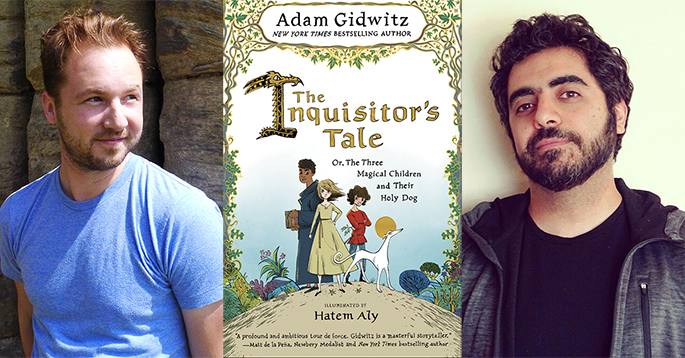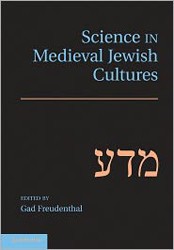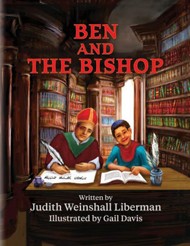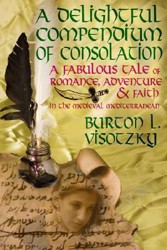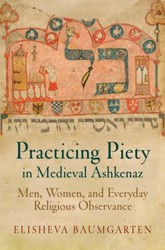with Teri Markson
Adam Gidwitz and Hatem Aly’s new book The Inquisitor’s Tale recently won The Sydney Taylor Award in the Older Readers Category and was named a National Jewish Book Award Finalist for Children’s Literature and a Newbery Honor Book. Jewish Book Council talked to the writer-illustrator team to discuss the book and their approaches to creating compelling literature for young Jewish readers.
Teri Markson: In addition to receiving many starred reviews and accolades, The Inquisitor’s Tale has won the Sydney Taylor Book Award in the Older Readers category and was a finalist for the National Jewish Book Award. Yet the book isn’t singularly focused on the Jewish character or Judaism itself. How do you account for the reaction from the Jewish community?
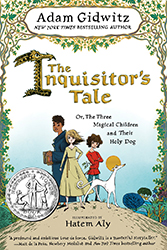 Adam Gidwitz: This has been one of the most satisfying elements of the recognition The Inquisitor’s Tale has received. It’s always a dangerous proposition to try to explain why someone likes your work, but I think the overwhelmingly positive reaction from the Jewish community derives from at least two sources:
Adam Gidwitz: This has been one of the most satisfying elements of the recognition The Inquisitor’s Tale has received. It’s always a dangerous proposition to try to explain why someone likes your work, but I think the overwhelmingly positive reaction from the Jewish community derives from at least two sources:
So much of the children’s literature featuring Jewish characters that receives national attention concerns the Holocaust. But Jewish history is so much richer than that! Jews have been writing and learning and praying and inventing for, by our count, over five millennia. I think people are appreciating a rich and detailed account of a period other than the Holocaust — an account that describes a very different kind of persecution of Jews; and also features and celebrates one of the great accomplishments of Jewish culture: the Talmud.
Secondly, in all literature — and especially literature for children — bad guys are usually stereotypically bad, and good guys are perfectly good. This is exaggerated in cases of persecution, such as the persecution of Jews. In The Inquisitor’s Tale, I tried to depict the Jewish community with some complexity — we’re definitely not all sages and saints — and, more crucially, I tried to portray the persecutor, King Louis IX, with realistic complexity. Louis was so beloved that he was sainted, and has a major American city named after him. Having read a number of sources on him, including critical sources, I understand why: he was in many ways a wonderful king and a wonderful man. But he was also viciously anti-Jewish. How could he be both? He said he hated the Jews, and supposedly claimed he would happily see a Jew stabbed in the stomach, yet he largely prohibited violence against them in his kingdom, unlike other monarchs of his time. Humans are complex, and my goal was to depict them in all their complex glory. Why would this appeal to Jewish community? You know what they say: two Jews, three opinions? We revel in complexity.
TM: One of the protagonists in the book, William, is biracial, of both African and European descent. How likely would it have been for that to have happened in the Middle Ages?
AG: It was certainly rare to see someone with brown skin in Northern France in the thirteenth century, mixed race or not. But there was a great deal of cultural interaction, in all senses, along the cultural borders of Europe: in the Middle East, along the edges of the Byzantine Empire, and in Spain. My character William is based in part on Guilhem d’Orange, a ninth-century Paul Bunyan-type figure who fought to take Spain from its Muslim rulers. I certainly didn’t like the idea of a religious warrior as the star of my book — it would defeat the whole intent of the story — so I thought that it would be interesting to focus on one of the little-talked-about (and, frankly, ironic) products of this religious war: a child of both sides.
TM: Many of the details in your book are based on your extensive research into the history and lore of the Middle Ages. What do you find most compelling about this era?
AG: The Middle Ages is a remarkably surprising period. I think most of us think of that time as boring and homogenous, constricted and made ignorant by faith. But in reality this couldn’t be farther from the truth! It was an age of invention, of great philosophy and architecture, a time of cultural collision and collaboration. Also, they told amazing stories, like ones about holy dogs, and dragons with deadly flatulence. How can you not find that compelling?
TM: What kind of response have you received from children and teens who have read the book? Do you think they’re more focused on the history or the humor?
 AG: Mostly, young people are focused on the adventure. The most compelling aspect of any novel is suspense — be it a romance, a comedy, a horror, what have you. Suspense is the engine that drives a novel. There are certain adult novels that eschew suspense, but those seem to lack an engine altogether, and mostly ramble randomly down the side of a steep hill. The suspense of The Inquisitor’s Tale comes in the form of adventure. But humor is important, too, and the big questions that I pose, about history, philosophy, and cultural difference, make the novel something that, I hope, young people will return to.
AG: Mostly, young people are focused on the adventure. The most compelling aspect of any novel is suspense — be it a romance, a comedy, a horror, what have you. Suspense is the engine that drives a novel. There are certain adult novels that eschew suspense, but those seem to lack an engine altogether, and mostly ramble randomly down the side of a steep hill. The suspense of The Inquisitor’s Tale comes in the form of adventure. But humor is important, too, and the big questions that I pose, about history, philosophy, and cultural difference, make the novel something that, I hope, young people will return to.
TM: One of my favorite moments in the book is when Marmeluc questions Jacob about what makes him a Jew. There are many instances where you have the children grapple with some complex religious ideas, including the death of Jacob’s parents in light of God’s plan. How did you decide what was appropriate for kids?
AG: I didn’t. I have a rule for my books: they have to have happy endings, and nothing sexual. Other than that, I think kids can handle most anything. (Okay, I exclude gratuitous torture, too. Mostly.) I taught elementary and high school for a combined eight years, and one thing I learned is that kids love hard questions. Hard questions motivate them and inspire them — not hard like tedious; hard as in challenging the way they’ve always seen the world. Each and every kid’s job is to grow, and nothing helps a kid grow like questions that make them reconsider what they always believed. Also farting dragons. That helps a kid grow, too.
TM: Whose decision was it to present the illustrations in the style of an illustrated manuscript? Did you consider starting the chapters with large ornate letters like in some old manuscripts? What other decisions did you make concerning the style?
Hatem Aly: The style or form of the book was decided early on. The idea was inspired by illuminated manuscripts, with marginalia specifically in mind. I had thought of starting each chapter’s first letter with a small illuminated character; then it was suggested to work on the “C’s in each “Chapter,” which was the best (and most sensible) way to use this technique for the book! The one decision that I obliged myself to do was inking the illustrations traditionally, using a metal nib or a “plume” like in the medieval times, to keep the artwork authentic to the time period — and have fun with the rest.
TM: Was the use of color considered at any point?
HA: For the interiors there was no intention to use color. However, now that I see it, I think the current form works best with the nature of the book and leaves space for imagination.
TM: Can you tell us something about the processes you used in illustrating the book?
HA: As I read the book the first time, I started sketching characters while doing some research on the time period in which the story takes place, paying closer attention to the visual aspects of people, places, and books. I made batches of sketches and discussed it with the editorial team, then I revised the sketches with their feedback and new research and started inking and finalizing. I must thank Adam Gidwitz for his expertise on many things I would not have known — like what some current locations or buildings looked like several centuries ago or how monks, peasants, or regular merchants dressed in medieval times.
TM: Most illustrated manuscripts are quite formal, but your style is very fluid — which works wonderfully with the humor in the book. What were you trying to achieve with your illustrations?
HA: Sometimes limitations are a great door to creativity. I used the formal tradition of illuminated manuscripts and the restrictive area of illustrative marginalia as an anchor that kept me in the right direction; within those strictures I allowed any ideas to flow freely, knowing that at the end it would be contained in the proper form. You could say it’s like singing a folklore poem in your own melody but staying truthful to the lyrics. And that works beautifully if you think the text is fantastic. In brief, I wanted the artwork to be both fun and passionate, like the story and characters of The Inquisitor’s Tale.
Teri Markson has been a children’s librarian for over 18 years. She is currently the acting senior librarian at the Valley Plaza Branch Library in North Hollywood, CA.
View Hatem Aly’s early sketches for The Inquisitor’s Tale:
(Click on the thumbnails below to enlarge images and enter the slideshow.)
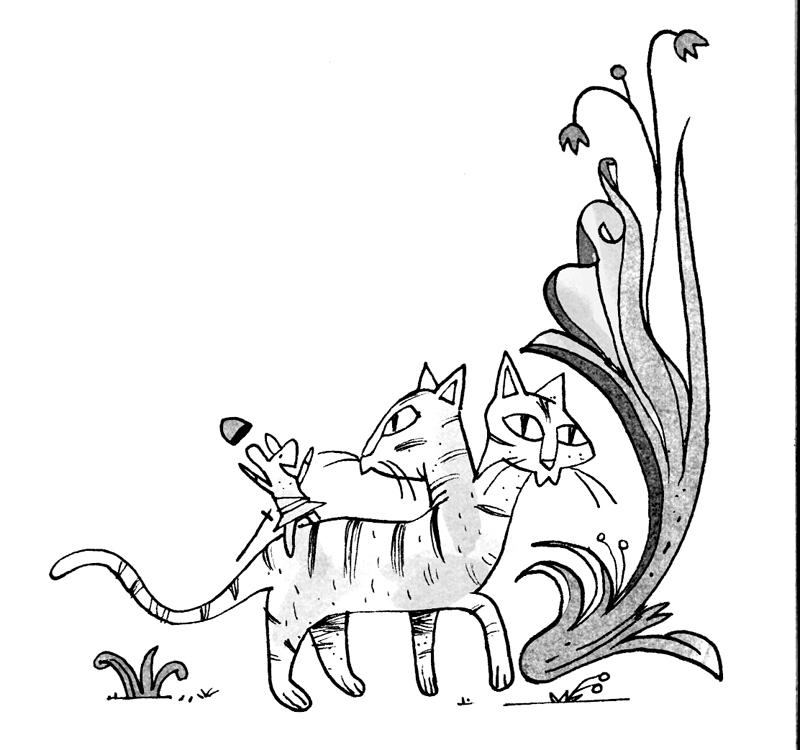 | 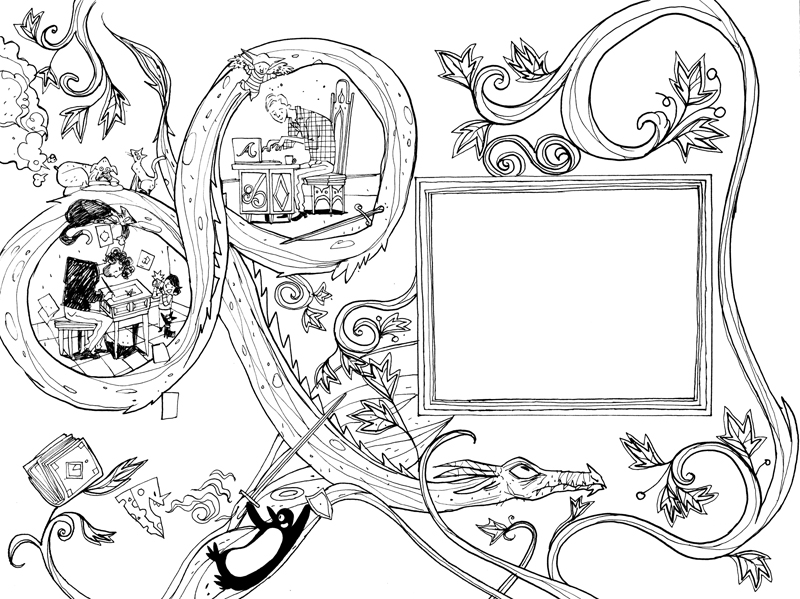 | 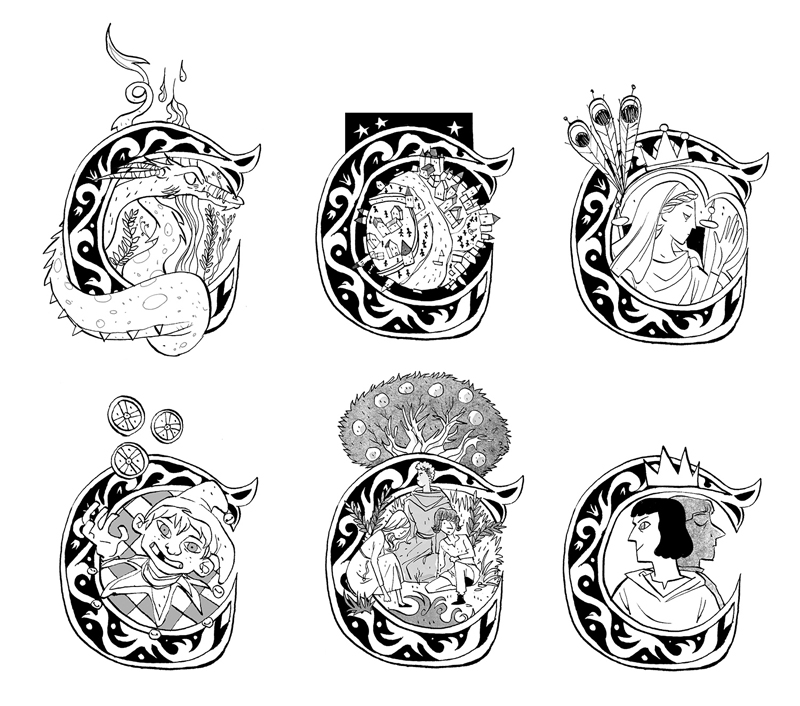 | .jpg?Action=thumbnail&Width=80&Height=80&Algorithm=proportional&USM=1) |
.jpg?Action=thumbnail&Width=80&Height=80&Algorithm=proportional&USM=1) | .jpg?Action=thumbnail&Width=80&Height=80&Algorithm=proportional&USM=1) | .jpg?Action=thumbnail&Width=80&Height=80&Algorithm=proportional&USM=1) | .jpg?Action=thumbnail&Width=80&Height=80&Algorithm=proportional&USM=1) |
.jpg?Action=thumbnail&Width=80&Height=80&Algorithm=proportional&USM=1) | .jpg?Action=thumbnail&Width=80&Height=80&Algorithm=proportional&USM=1) | .jpg?Action=thumbnail&Width=80&Height=80&Algorithm=proportional&USM=1) | .jpg?Action=thumbnail&Width=80&Height=80&Algorithm=proportional&USM=1) |
| Next | |||
Related Content:
